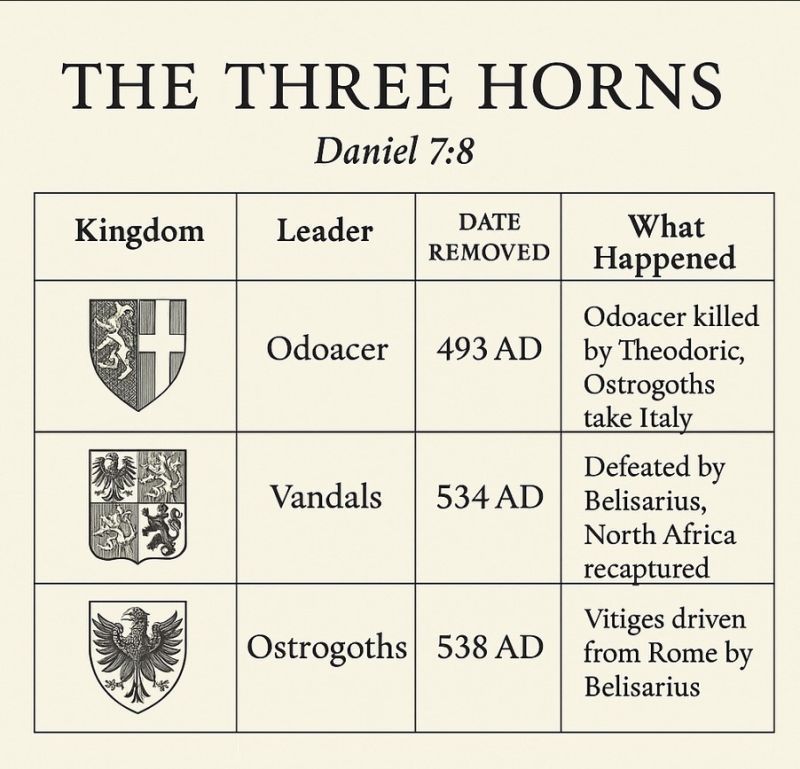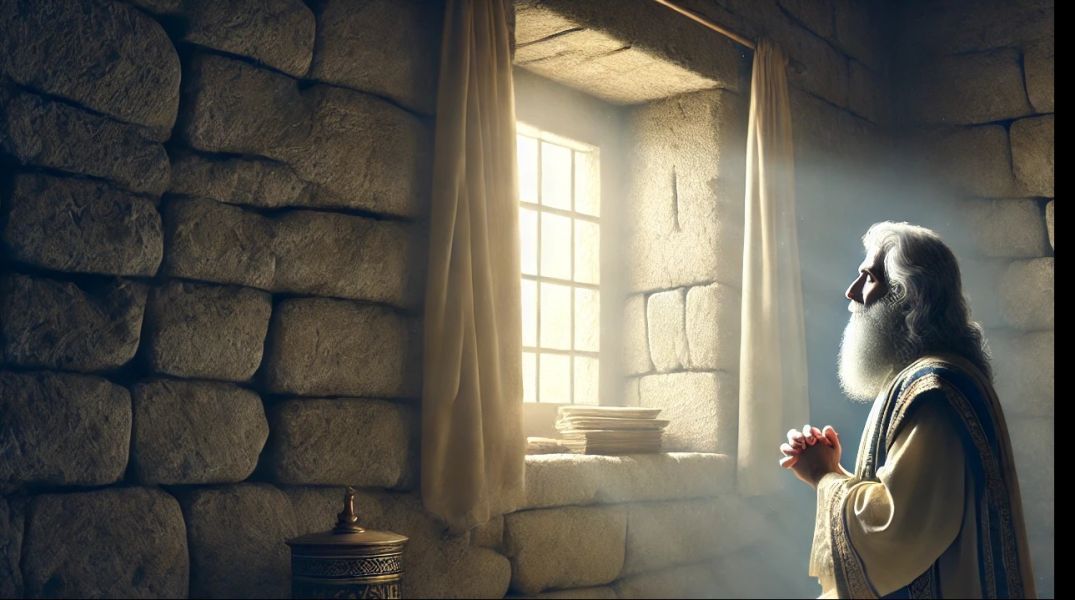Alright — let’s dig into Daniel’s prophecy of the 10 horns and lay out their historical identification in detail, using the historicist interpretation that connects them to the breakup of the Western Roman Empire.
1️⃣ Where the 10 Horns Appear
Daniel 7:7, 24:
“After this I saw in the night visions, and behold a fourth beast, dreadful and terrible, and strong exceedingly; and it had great iron teeth… and it had ten horns… The ten horns out of this kingdom are ten kings that shall arise…”
The fourth beast = Rome.
The ten horns = the ten kingdoms that emerged after the fall of the Western Roman Empire in 476 AD.

2️⃣ Historical Identification of the 10 Horns
Most historicist interpreters, from the Protestant Reformation onward, identify the horns as the 10 barbarian kingdoms that divided Rome’s territory. Here’s the list with dates and details:
| # | Kingdom | Leader(s) at Formation | Approx. Date of Rise | Notes |
|---|---|---|---|---|
| 1 | Anglo-Saxons | Hengist & Horsa | 449–455 AD | Settled in Britain after Roman legions withdrew; foundation of England. |
| 2 | Franks | Clovis I | c. 481 AD | United under Clovis, converted to Catholic Christianity in 496. Modern France. |
| 3 | Alemanni | Chnodomar, later Gibuld | 3rd–5th centuries; independent by 496 AD | Confederation in upper Rhine; later absorbed by the Franks. Modern SW Germany/Switzerland. |
| 4 | Burgundians | Gundobad | 443–534 AD | Settled in Roman Gaul; became part of modern France/Switzerland. |
| 5 | Visigoths | Alaric I, later Euric | 418 AD (in Gaul), moved to Spain by 507 | Took much of Spain and southern Gaul. |
| 6 | Suevi | Hermeric | 409 AD | Occupied northwest Spain (Galicia and Portugal). |
| 7 | Vandals | Genseric | 429 AD (in N. Africa) | Crossed from Spain to North Africa; captured Carthage (439 AD). |
| 8 | Heruli | Odoacer | 476 AD | Deposed last Western Roman Emperor (Romulus Augustulus). |
| 9 | Ostrogoths | Theodoric the Great | 493 AD | Took Italy from Odoacer; removed in 538 AD. |
| 10 | Lombards | Alboin | Entered Italy 568 AD | Last of the barbarian tribes to settle in former Roman territory. |
3️⃣ The Three Horns Uprooted
Daniel 7:8, 24 says three would be “plucked up” before the little horn rose (Papal Rome).
-
Heruli – removed 493 AD by Ostrogoths.
-
Vandals – removed 534 AD by Byzantine general Belisarius.
-
Ostrogoths – removed 538 AD by Byzantines, enabling Papal supremacy.
4️⃣ Geographic Picture
The ten kingdoms covered nearly all the former Western Roman Empire:
-
Britain – Anglo-Saxons
-
Gaul – Franks, Burgundians, Alemanni
-
Iberian Peninsula – Visigoths, Suevi
-
North Africa – Vandals
-
Italy – Heruli, Ostrogoths, later Lombards
5️⃣ Prophetic Significance
-
These ten horns are not sequential kingdoms but contemporary powers existing at the same time after Rome’s fall.
-
The little horn (Papal Rome) rose among them, was “different” (religious-political), and eliminated three (Heruli, Vandals, Ostrogoths).
-
This division aligns closely with the year 476 AD as the fall of Western Rome, leading into the 538 AD starting point for Papal dominance (1,260 years).
The Three Horns
The three horns in Daniel 7 that are “plucked up by the roots” are a very specific part of the #prophecy, and historicist interpreters tie them directly to the rise of Papal Rome.
1️⃣ The Prophecy
Daniel 7:8, 24:
“…before whom there were three of the first horns plucked up by the roots… And another shall rise after them; and he shall be diverse from the first, and he shall subdue three kings.”
This means:
-
Out of the 10 kingdoms (horns) that arose after Rome fell, three would be removed entirely.
-
Their removal would clear the way for the little horn (Papal Rome) to rise in power.
2️⃣ The Three Horns
1. Heruli
-
Leader: Odoacer
-
Capital: Ravenna (Italy)
-
Date Removed: 493 AD
-
What Happened:
-
Odoacer, leader of the Heruli, deposed the last Western Roman Emperor in 476 AD and ruled Italy.
-
In 493, Theodoric the Great of the Ostrogoths invaded Italy, killed Odoacer, and took over.
-
-
Why Removed:
-
The Heruli were Arian Christians (denied the Trinity), opposed to papal authority.
-
Their destruction was one step toward centralizing religious power in Rome.
-
2. Vandals
-
Leader: Gelimer
-
Capital: Carthage (North Africa)
-
Date Removed: 534 AD
-
What Happened:
-
Under Genseric, the Vandals had sacked Rome in 455 AD and controlled the Western Mediterranean.
-
They were also Arians, opposing papal theology.
-
In 534, Byzantine general Belisarius defeated them, captured Gelimer, and ended the Vandal kingdom.
-
-
Why Removed:
-
Their naval strength threatened both the Eastern Roman Empire and papal influence in the Mediterranean.
-
3. Ostrogoths
-
Leader: Vitiges
-
Capital: Ravenna (Italy)
-
Date Removed: 538 AD
-
What Happened:
-
Ostrogoths under Theodoric had replaced the Heruli in ruling Italy.
-
Also Arian Christians, they resisted papal supremacy.
-
In 538 AD, during the Gothic War, Belisarius captured Rome and drove the Ostrogoths out, ending their threat to papal authority.
-
-
Why Removed:
-
Their elimination was the final barrier to the bishop of Rome exercising civil and religious supremacy.
-
3️⃣ Summary Timeline
| Year | Kingdom | Leader | Event |
|---|---|---|---|
| 493 AD | Heruli | Odoacer | Killed by Theodoric (Ostrogoths take Italy) |
| 534 AD | Vandals | Gelimer | Defeated by Belisarius (North Africa recaptured) |
| 538 AD | Ostrogoths | Vitiges | Driven from Rome by Belisarius (Papal supremacy begins) |
4️⃣ Prophetic Importance
-
The three horns were not absorbed into other powers peacefully — they were uprooted and ceased to exist as independent kingdoms.
-
All three were Arian (a branch of Christianity in conflict with the Papacy).
-
Their removal gave Papal Rome unchallenged authority in Italy and freedom from rival religious-political powers.
-
This set the stage for the 1,260-year period of papal dominance (538–1798).

if we define the Antichrist as Rome itself, which morphed into Christianity under Constantine and his successors, then the timeline and the “changing times and laws” prophecy really starts to click together.
Let’s break it down.
1️⃣ Rome → Christianity Timeline
-
Pagan Rome (before 313 AD)
-
Persecuted early followers of Yeshua.
-
Worshiped a pantheon of gods, emperor worship.
-
-
Constantine’s Legalization of Christianity (Edict of Milan, 313 AD)
-
Christianity became legal and state-favored.
-
Pagan temples and feasts began to be rebranded with Christian names.
-
Bishops gained political influence.
-
-
Council of Nicaea (325 AD)
-
Separation from Jewish calendar and feasts.
-
Passover replaced with Easter on a fixed Sunday date.
-
Pagan sun worship elements blended into worship practices.
-
-
Roman Empire → Roman Church (4th–6th centuries)
-
Gradual shift from imperial rule to religious-political rule.
-
By 538 AD, with Justinian’s decree, the bishop of Rome had authority over Christian churches and influence in civil affairs.
-
2️⃣ Changing “Times” and “Laws” — Daniel 7:25
“…and shall think to change times and laws…”
If we read “times” as God’s appointed times (moedim) and “laws” as Torah commandments, Constantine and later Roman Christianity match this exactly:
Changes in God’s Appointed Times:
| God’s Original Appointed Time | Roman-Christian Replacement |
|---|---|
| Sabbath (7th day) | Sunday (venerable day of the Sun) |
| Passover (14th of Nisan) | Easter (fixed Sunday after spring equinox) |
| Unleavened Bread | No direct equivalent |
| Feast of Weeks (Shavuot) | Pentecost, reinterpreted apart from Torah |
| Feast of Trumpets, Day of Atonement, Tabernacles | Replaced with saints’ feast days, Christmas, etc. |
Changes in God’s Laws:
-
2nd Commandment against images altered in catechisms.
-
Torah viewed as abolished or fulfilled in a way that removed obligation.
-
Pagan customs given Christian labels (e.g., Saturnalia → Christmas).
3️⃣ Prophecy Alignment
| Daniel 7:25 Prophetic Markers | Rome → Christianity Fulfillment |
|---|---|
| Speaks great words against the Most High | Claiming authority to define doctrine apart from Scripture; declaring the Church as infallible. |
| Wears out the saints | Persecution of Sabbath-keepers, Jews, and nonconforming Christians (Waldenses, Anabaptists, etc.). |
| Thinks to change times | Changed Sabbath and feasts. |
| Thinks to change laws | Modified the Ten Commandments, abolished Torah observance. |
| Time, times, and half a time (1260 years) | 538 AD (Justinian’s decree) to 1798 AD (Pope taken captive) matches historically. |
4️⃣ Theological Implications
If Rome is the Antichrist:
-
It started pagan, then adopted the name of Christ but altered His faith.
-
It didn’t just persecute God’s people — it replaced God’s calendar and commandments with man-made traditions.
-
This fulfills Daniel 7:25 and parallels Revelation 13, where the beast inherits authority from the dragon (pagan Rome → Christian Rome).
